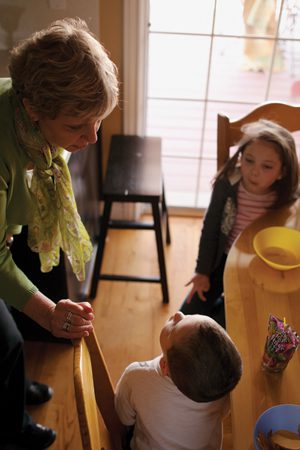Given time and space, grieving families can strengthen bonds.
When Sharlee Mullins Glenn (BA ’85, MA ’89) was 5 years old, her father died in a mining accident. Four months later, her oldest brother drowned. The intense grief that followed for Sharlee, her mother, and her five remaining siblings forged a family strength that has served them well for 50 years now. Not only did they survive, but they grew in understanding, love, and commitment. “We were always a loving and affectionate family, but after those deaths, we became incredibly tight,” says Glenn. “We became a family of best friends. People often commented on how close we were, how affectionate. Not that we didn’t have our squabbles, but our ultimate devotion to each other was never a question.”
But tragedies don’t automatically draw families closer, says Karen de la Cruz, an assistant teaching professor in the College of Nursing who specializes in transcultural death and grief. “Whatever the family dynamics are before a death or other stressful event, they’re accentuated when a stressor hits. Dysfunctional families may become more dysfunctional without intervention. Healthier families will likely fare quite well and can even thrive,” says de la Cruz, who was widowed in her 40s and has learned about death and grief for 30 years as a pediatric-oncology, emergency-room, and intensive-care nurse.
De la Cruz recommends that families prepare for inevitable losses by continuously strengthening their family relationships and learning basic grieving principles.
Companions in Grief
As families grieve together, they can be intentional about supporting one another. They can allow venting, reminisce together about the deceased, and look out for each other. When Glenn’s father and brother died, she says all the siblings “watched each other’s backs.” When she was in the fourth grade, she gave a “good pounding” to a sixth grader who was picking on her little brother.
De la Cruz had two children in middle school when her husband died suddenly in 2004. They would see each other in the halls and check out how they were doing just by looking at each other’s faces. “If they reached a point during the day when they couldn’t cope, they could flash a signal and the other would step in to help,” she says.
This healthy looking out for one another presupposes a family culture where supportive behaviors are already consistent. When tragedy occurs in such families, they can lean on each other when they’re feeling shaky. Supportive families, says de la Cruz, remember that “God put us on this earth to help each other and that we’re all going to go through tough times.”
There’s No Right Way
Researchers have suggested many grief models over the years, such as Elizabeth Kübler-Ross’s five stages of grief (denial, anger, bargaining, depression, acceptance), but these are just constructs for trying to make sense of an experience that usually doesn’t make much sense, says de la Cruz. And they can do harm when used to dictate how a person “ought” to grieve.
“The five stages are rough guidelines,” she says. “They don’t happen in order, and they’re much more fluid than was originally thought. You can go back and forth between them, you can be in more than one stage at once, and not everyone goes through every stage.”
People grieve according to their own temperament, coping style, age or stage of life, relationship with the deceased, and previous experiences, especially experiences with death, says de la Cruz. When grieving family members criticize one another for being “too emotional” or “not talking about it enough,” they can further injure their already hurting loved one.
When de la Cruz’s husband died, their youngest daughter, then age 11, could not face it. “If anyone asked her about her dad, she would say he was on a business trip. That’s how she coped with it. It seemed totally bizarre to the rest of us, but we gave her the time and space to deal with her grief in her own way. None of her nine siblings tried to force her to admit that Daddy was dead.”
“Your way of grieving is not the ‘right way’ to grieve. It’s just your way. [Another’s] way of grieving, even though it might be very different from yours, is just as legitimate.”
No Timetable
When her husband died, de la Cruz presumed that because she had dealt so much with death in her work, she could speed up her grieving. “I thought, ‘I know how this grieving thing works. I’m just going to go straight to acceptance.’ It did not work. Just because you know the process doesn’t mean you can take shortcuts. But boy, did I try.”
In the American work culture, employees are generally given three days of bereavement leave for the death of a close family member—three days to be with the dying loved one, plan and put on a funeral, and spend time with loved ones who have gathered.
“Then you’re expected to get back to work,” says de la Cruz. “If someone persists in grieving for any extended length of time, it’s not unusual for a boss or colleagues to say, ‘Really? It’s been six months. Aren’t you over this yet? You need to get on with your life.’”
But de la Cruz says that grief is a process, and people need time and space for it. Though society doesn’t allow for realistic grieving time, individuals can draw boundaries for themselves, such as working fewer hours if possible or taking a daily nap.
Though grief diminishes over time, the idea that it will simply end is a myth, says de la Cruz. For her, the constant, excruciating rawness of early grief gave way to milder feelings, but even now, 12 years later, she has tough moments. “There are days when I still don’t accept his death,” she says. “‘Where are you? You should be helping me!’ It isn’t constant, but it still pops up. That’s perfectly normal.”
The Benefits of Grief
As grieving individuals and families move further from the death of their loved one, they can begin to look back and see the good. “If they’re patient, they’ll see what they’ve gained,” says de la Cruz. “Now I recognize my grief has made me more compassionate and more understanding. It’s also made me quicker to recognize markers of grief in others so I can be supportive to them.”
Glenn and her siblings are all now grown and deeply value the resilience they developed after their father’s and brother’s deaths: “We passed through hard things and survived. We’re spread from Utah to Alaska to Washington state to Oregon, but we still have each other’s backs. Our oldest sister was recently diagnosed with breast cancer, and it was heartwarming to see the way we all came together to help and support her.”
Like Glenn, de la Cruz found that when death arrived in her home, her family rose to the challenge. “We had loving relationships, but I really didn’t know how it was going to play out. I was amazed at how these kids nurtured each other and supported each other. We always hope our kids learn what we teach them, and it was beautiful to see that mine had.”
How to Mourn with Those That Mourn
From her 10 years as a hospice chaplain and bereavement counselor, author Sue Bergin shares this list of what to do—or not do—to support grieving friends or family.
• Don’t assume you have to talk. A hug or a squeeze of the hand can be more comforting than words.
• Don’t tell your own grief story unless asked.
• Don’t offer advice—of any kind.
• Don’t assume that if someone understands the plan of salvation, they will have less need to grieve.
• Don’t say things like “He’s in a better place” or “At least her suffering is over.” Any sentence that begins with the phrase “at least” is received as minimizing and isn’t comforting.
• Don’t impose your personal beliefs about death and the afterlife on the griever.
• Do give grievers your full, focused attention.
• Do share your memories of the loved one and encourage grievers to share theirs.
• Do invite grievers to short, low-intensity activities, such as lunch, family home evening, or a walk or bike ride.
• Do allow a griever to express his or her honest feelings, including anger at God and anger at the deceased.
• Do share a book or other resource that has helped you with grief.












